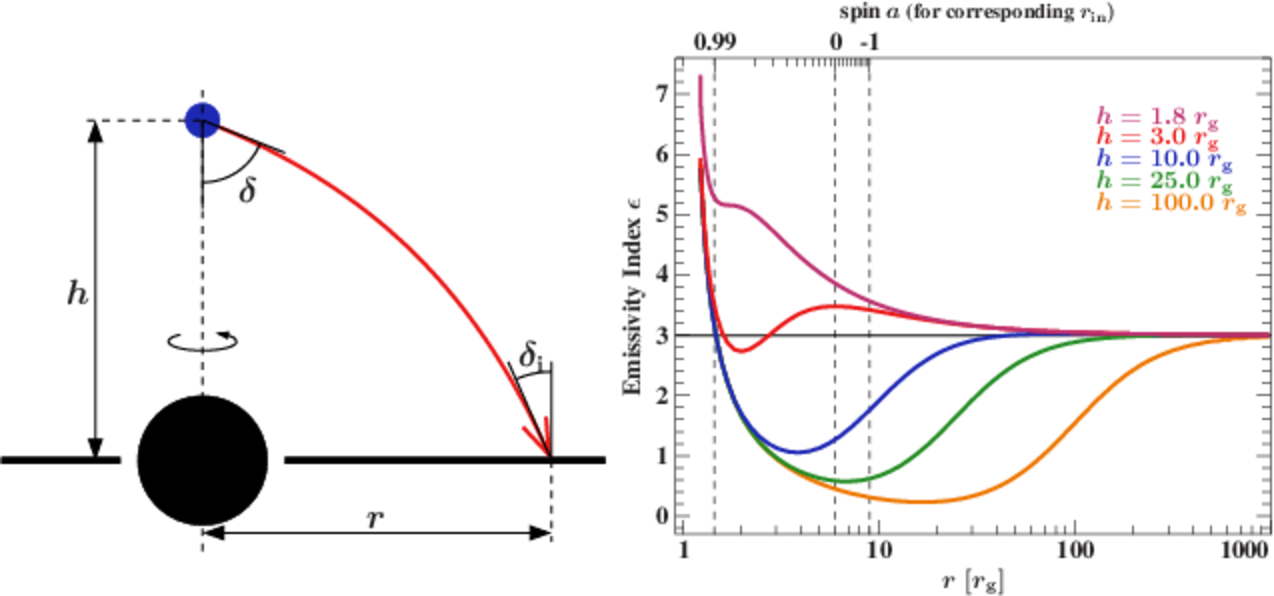WARNING: This code is no longer updated and maintained. Please use the RELXILL model, which also contains RELLINE, which can be downloaded here.
If you want to receive notifications about new versions of the model (including changes such as bug fixes or new interfaces), please send me an email. As this code is still in beta test, I recommend to do so.
NEWS (display all changes):
- 2013-03-19: Version v0.4c. The environment variable "RELLINE_TABLES" can now be used to set the path to the relline tables individually.
- 2013-02-22: Version v0.4b. Finally, the height of the lamp post source can also be fitted for values smaller than 3rg, as close as 10% away from the event horizon of the black hole.
Introduction
This page contains a copy of the test code of a new code to calculate relativistic line profiles. This code is compatible with common X-ray data analysis software (XSPEC, ISIS) and can be easily installed (instructions below). The two basic forms are an additive line model (RELLINE) and a convolution model to calculate relativistic smearing (RELCONV). More details regarding the basic relline code can be found in a paper titled
Dauser, Thomas; Wilms, J.; Reynolds, C. S.; Brenneman, L. W.,
2010, MNRAS, 409, 1534-1540, ADS link
2013, MNRAS, 687 ADS link
Lamp Post Geometry
Since version v0.2 it is also possible to model data, assuming the lamp post geometry, i.e., a hard X-ray source above the black hole is irradiating the accretion disk. This leads to a different emissivty than the broken power law of the "normal" relativistic models. Below is an image showing how the emissvity index changes throughout the accretion disk. This introduces the new models RELLINE_LP, RELCONV_LP, RELLINE_LP_EXT, and RELCONV_LP_EXT. Models with LINE work very similar to the RELLINE model, whereas CONV implies that the model is a convolution model, similar to RELCONV. Models marked with EXT, are the most "extended" ones, meaning they allow to model a radially extended source, which might even have a non-zero velocity gradient. More information and plots can be found in Dauser et al. (2013).

Installation
Before the installation, please make sure that you have at least xspec 12.6.0e installed on your system. This is necessary for a successful compilation of the model code. To install, please download the following files:
| last changes | in version | |
| relline_code.tgz | 2013-03-19 | v0.4c |
| tables.fits.tgz (warning: 18MB) | 2013-02-22 | v0.4b |
To compile the model, put all of these files into a directory, and unpack them:
tar xfz tables.fits.tgz tar xfz relline_code.tgz
In order to compile the model, it is recommended that you call the provided compile-script by executing:
chmod u+x ./compile_relline.csh ./compile_relline.cshIn this way the path to the tables will be correctly set in the model code, allowing you to properly load the model from any location.
ALTERNATIVE: If you don't want to use this compile script, you can also set the path to the tables by setting the environment variable "RELLINE_TABLES" to the directory which contains the tables.
Loading the models
To load the local model from within xspec, load the model with the command
lmod relline .(do not forget the "."!) The model for the line shape is called RELLINE, the convolution model (to be used, e.g., to calculate relativistic smearing) is called RELCONV. Models in the lamp post geometry have the same name convention, but just different endings (_LP, or _LP_EXT, for an extended primary source).
Using the models
The parameters used in the different implementations are explained in the following:| linieE: | line energy in the restframe of the disk |
| Index1: | emissivity index for r < Rbr |
| Index2: | emissivity index for r > Rbr |
| Rbr: | radius where emissivity changes from Index1 to Index2 |
| a: | spin of the black hole |
| Incl: | inclination angle measured with respect to the normal of the disk |
| Rin: | inner radius of the disk |
| Rout: | outer radius of the disk |
| h: | height of the primary source |
| hbase: | lower height of a radially extended primary source |
| htop: | upper height of a radially extended primary source |
| vbase: | velocity of the source at hbase |
| v100: | velocity of the source at 100 rg above hbase |
| gamma: | Power Law Index of the primary source (E^-Gamma) |
| z: | redshift to the source |
| limb: | limb-darkening/-brightening law for mu=cos(emission angle): |
| 0 = isotropic, 1 = darkening (flux ~ 1+2.06mu), 2 = brightening (flux ~ ln(1+1/mu)) | |
| h: | height of the primary source in the lamp post geometry |
Important: Note that the inner and outer radii of the accretion disk and the break in the emissivity, (parameters Rin, Rout and Rbr) are given either in units of the innermost stable circular orbit for the current value of a (parameter value is negative) or in gravitational radii (rg) GM/c^2 (parameter value is positive). From v0.4b on, a similar meaning applies to the height parameters (h, hbase and htop)): Negative values mean that the parameter value is given in units of the event horizon (rplus), where rplus=1...2, depending on the spin of the black hole. This parametrization is useful for sources at very low height, in order to make sure that the emitting source is outside the event horizon of the black hole. As before, the "normal" meaning of the height in units of rg is maintained by a positive parameter value. When changing sign, please do not forget to also change the hard and soft limits for these parameters in order to avoid problems during fitting!
The code here is still in beta-test! Please contact me if you find bugs or encounter problems with the model.



